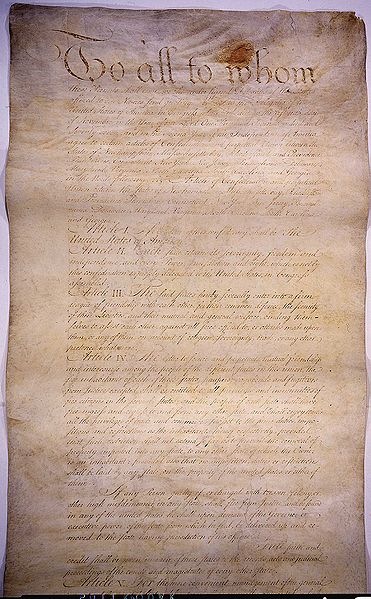The Articles of Confederation was a written agreement, uniting the thirteen founding states, and serving as the states’ first constitution, or set of principles by which the states was governed. Formerly named the Articles of Confederation and Perpetual Union, the set of fundamental principles provided the first step in creating a government for the states as a nation. It provided the Continental Congress domestic and international power to oversee the American Revolutionary War, and to execute diplomacy in dealing with Europe, Native American relations, and territorial issues.
The Articles were formally ratified by the states in 1777, but due to the weak government created, a new draft which would become the United States Constitution replaced the Articles in 1789. The Constitution built on the same principles and foundation as the Articles of Confederation, yet provided for a much stronger government of the newly-united states. The Constitution added a chief executive (President), a court system, and taxing powers.
A Need for Articles Development
In 1754, increased cooperation among the colonies seemed to be a necessity. Benjamin Franklin proposed intercolonial collaboration as an initial step in an attempt to provide union, government, and communication. By 1775, events of the American Revolutionary War were occurring before the Second Continental Congress was informed, which furthered the need for more controlled organization of communications, and power of the states.
In 1776, Thomas Paine pointed out the need for the states to declare their independence in his pamphlet, Common Sense. As long as other countries considered the states to be allied with Great Britain, any foreign trade would diminish. For these reasons, America found a necessity to be in the same league as other independent nations.
Articles Organization
In June, 1776 Congress created committees to write drafts for three very important documents in American history. The Declaration of Independence was drafted to announce the states’ entry into the international system. The Model Treaty, or the Plan of 1776, was to establish commerce with other states. The Articles of Confederation was to establish a union of the thirteen independent states, and to define principles and agreements for vital foreign and domestic affairs.
During the Second Continental Congress, the Articles were created by delegates from the each state. The delegates were constructing a document to ensure freedom, sovereignty, and independence of the United States. The original document consisted of five pages. Included were the preamble, thirteen articles, a conclusion, and signature pages. The Articles ratification took several years, due to the refusal of some states to give up claimed land in the West.
Major Difference between the Articles and Constitution
Many of the same principles were used in both the Articles of Confederation and the Constitution. The Constitution was written to address weaknesses found in the Articles. The Articles created a unicameral, or one chamber legislature, with no executive or judicial branch, and therefore, no separation of power.
The Articles granted very little power to this central government. There was no authority for the government to tax, raise money for common defense, or to regulate interstate trade. Another differing factor of the Articles was pertaining to votes. A unanimous vote of the thirteen states was required to amend the Articles, and nine of thirteen votes were required to pass laws. This was not only difficult, but almost impossible to do.
While the foundation and principles of the Articles of Confederation were on the right track, changes pertaining to paying off state and national debts, state votes, and a more powerful bicameral, or two legislature governments was deemed necessary, eventually leading to the creation of the United States Constitution. Continue to the Full Text »
